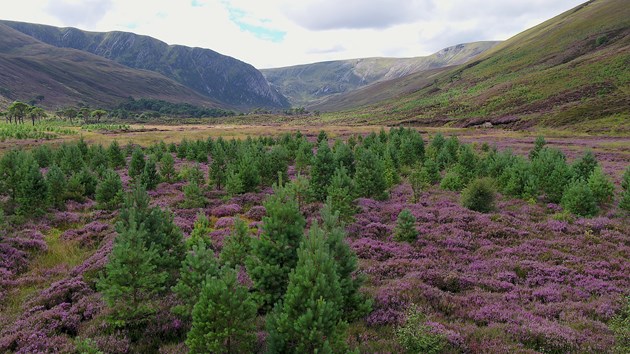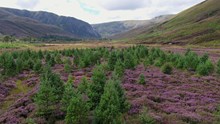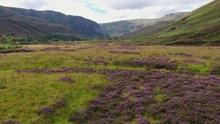10 November, 2023
Rare Caledonian pinewood restored at the Alladale wilderness reserve

A remote fragment of Scotland’s ancient Caledonian pinewood in Sutherland has been restored thanks to two decades of effort, NatureScot reports.
This globally unique habitat can only be found in the Scottish Highlands. It provides a home for a wide variety of rare and specialised species, including pine martens, conifer specialists like crossbills and red squirrels, as well as butterflies, lichens, fungi and wildflowers such as twinflower and creeping lady’s tresses.
At its peak, woodland may have covered 70% of Scotland but historic climate change, together with forest clearance for agriculture, led to a decline. Now only 84 fragments of the important and iconic Caledonian pinewood remain, scattered across the Scottish Highlands.
A four-year study by the conservation charity Trees For Life found that 23% of all the Caledonian Pinewoods are critically threatened. A major pressure on these small fragments is high levels of deer browsing which prevents new generations of pines from establishing. The mature ‘granny’ pines get older and naturally die without a new generation of trees being able to establish and to grow in their place. A small fragment of the Caledonian Pinewood at the Alladale wilderness reserve near Bonar Bridge was in this situation and had been categorised by NatureScot as being in unfavourable and declining condition.
The Caledonian pinewood at Alladale is the second most northerly fragment of this now critically rare habitat. It was designated as a Site of Special Scientific Interest by NatureScot (then Scottish Natural Heritage) in 1979. It is also recognised at a European level as a Special Area of Conservation in 2005.
The fate of this forest fragment changed in 2003 when it was purchased by Paul Lister who set about transforming the management of the estate, restoring natural habitats and saving this important pinewood fragment.
The Alladale team, with the support of NatureScot and the Scottish Rural Development Programme, fenced the pinewood fragment to relieve the deer grazing pressure and give an opportunity for pine seedlings to grow without the risk of being eaten. They also supplemented the forest area by planting almost a million new native trees.
Now, an area that had two decades ago been only a few old pines is once again thriving and the forest area has expanded massively. In addition to Scots Pine, rowan, willow and juniper are all increasing in area and abundance. In time, these young trees will themselves set seed, ultimately ensuring new generations and a resilient Caledonian forest once more.
This summer, NatureScot staff revisited the site to undertake an assessment of progress and found that the pinewood now meets all criteria to be officially classed as being in favourable condition.
Jeanette Hall, a NatureScot woodland specialist, said, “It’s wonderful to see the transformation of this ancient pinewood, particularly right now when nature restoration is so crucial part to tackle the biodiversity loss and climate change crises.
Steve Wheatley of NatureScot, who undertook this most recent survey, added, “We measure the condition of the important pinewoods against 15 different criteria which evaluate all the different layers of a native pinewood - from the canopy, to the health of the trees, to the shrub and ground layers, and all the way down to the soils. It was wonderful to see the Alladale Pinewood passing each one of these rigorous tests as the survey progressed.
“The survey was surprisingly hard work; in the absence of high deer pressure, the heather and blaeberry is now so high, just traversing the hill to undertake the survey was tiring but hugely rewarding work and it was a pleasure to spend time in such a special habitat and surrounded by nature.”
Reserve Manager at Alladale, Innes MacNeill, said, “A restored woodland and a healthy ecosystem is central to the vision for Alladale Wilderness Reserve. We have been working hard on this for two decades, so it is rewarding for us to reach this milestone and have this officially recognised. The hard work will obviously continue; our ethos at Alladale is simple: we will leave the land in better condition than it was found.”
James Rainey, Senior Ecologist at Trees for Life, said: "With the climate and biodiversity crises intensifying, enabling the recovery of Scotland’s remnant pinewoods has never been more important. A globally unique habitat that people have valued for centuries, pinewoods also provide refuge for some of our rarest wildlife - from twinflower and wood ants to capercaillie. Working collaboratively with land managers to protect ancient pinewoods is a fundamental first step to ensuring survival of these iconic woodlands.”
ENDS
Contact information
- Name
- NatureScot Media
- Telephone
- 0131 316 2655
- media@nature.scot
Notes to editors
PICTURES: The pictures show current restoration at the SSSI/SPA on Alladale wilderness estate, as well as a view of the SSSI/SPA before restoration. Pictures are free use; please credit Norman Strachan.
For more on Alladale wilderness estate, see their website.
NatureScot is Scotland's nature agency. We work to enhance our natural environment in Scotland and inspire everyone to care more about it. Our priority is a nature-rich future for Scotland and an effective response to the climate emergency. For more information, visit our website at www.nature.scot or follow us on X at https://x.com/NatureScot
’S e NatureScot buidheann nàdair na h-Alba. Bidh sinn a’ neartachadh àrainneachd na h-Alba agus a’ brosnachadh dhaoine gu barrachd suim a chur ann an nàdar. Tha e mar phrìomhachas againn gum bi nàdar na h-Alba beairteach agus gun dèilig sinn gu h-èifeachdach le èiginn na gnàth-shìde. Tha an tuilleadh fiosrachaidh aig www.nature.scot no air X aig https://x.com/NatureScot


